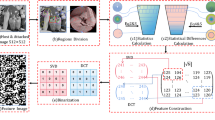Abstract
Digital zero-watermarking technology is an effective measure to protect image copyright, and many algorithms have been proposed based on zero-watermark. However, most of the existing zero-watermarking algorithms are designed for grayscale images. In this paper, a new zero-watermarking algorithm for color image based on tensor mode expansion is proposed. In the proposed scheme, four images of R, G, B, and gray are firstly generated from the original image. Then, the four images are appropriately combined to construct two three-dimensional tensors, and tensor expansion is performed on the obtained tensors. By performing singular value decomposition (SVD) and discrete cosine transform (DCT) on the expanded data, a feature image containing the main information of the host image can be generated. Finally, the feature image is fused with the specified logo image to obtain a zero-watermark image. Experimental results show that the proposed algorithm is robust to noise attacks and common image processing attacks, and better performances compared with some existing algorithms are also achieved. In addition, since the proposed algorithm is based on color images, it can make full use of all aspects of color images.







Similar content being viewed by others
References
Potdar VM, Han S, Chang E (2005) A survey of digital image watermarking techniques. https://doi.org/10.1109/INDIN.2005.1560462
Tao H, Chongmin L, Zain JM, Abdalla AN (2014) Robust image watermarking theories and techniques: a review. J Appl Res Technol 12(1):122–138. https://doi.org/10.1016/s1665-6423(14)71612-8
Wang CP, Wang XY, Xia ZQ (2016) Geometrically invariant image watermarking based on fast radial harmonic fourier moments. Signal Process Image Commun 45(C):10–23. https://doi.org/10.1016/j.image.2016.03.007
Shao Z, Shang Y, Rui Z, Shu H, Coatrieux G, Wu J (2016) Robust watermarking scheme for color image based on quaternion-type moment invariants and visual cryptography. Signal Process Image Commun 48:12–21. https://doi.org/10.1016/j.image.2016.09.001
Moosazadeh M, Ekbatanifard G (2017) An improved robust image watermarking method using dct and ycocg-r color space. Optik Int J Light Electron Opt 140:975–988. https://doi.org/10.1016/j.ijleo.2017.05.011
Singh SP, Bhatnagar G (2018) A new robust watermarking system in integer dct domain. J Vis Commun Image Represent 53:86–101. https://doi.org/10.1016/j.jvcir.2018.03.006
Quan W, Tanfeng S, Shuxun W (2003) Concept and application of zero-watermark. Acta Electron Sin 31(2):214–216. https://doi.org/10.3321/j.issn:0372-2112.2003.02.015
Leng XX, Xiao J, Li DY, Shen ZY (2013) Study on the digital image zero-watermarking technology. Adv Mater Res 5:765–767. https://doi.org/10.4028/www.scientific.net/AMR.765-767.1113
Li Z, Peng C, Tian X, Xia S (2011) A novel zero-watermarking algorithm based on DWT and edge detection. Int Congr Image Signal Process. https://doi.org/10.1109/CISP.2011.6100325
Han SC, Zhang ZN (2013) A novel zero-watermark algorithm based on LU decomposition in NSST domain. IEEE Int Conf Signal Process. https://doi.org/10.1109/ICoSP.2012.6491884
Rao YR, Nagabhooshanam E (2015) A novel image zero-watermarking scheme based on DWT-BN-SVD. Int Conf Inf Commun Embed Syst. https://doi.org/10.1109/ICICES.2014.7034073
Rani A, Bhullar AK, Dangwal D, Kumar S (2015) A zero-watermarking scheme using discrete wavelet transform. Procedia Comput Sci 70:603–609. https://doi.org/10.1016/j.procs.2015.10.046
Qiang Z, Wang Y, Levine MD, Yuan X, Long W (2015) Multisensor video fusion based on higher order singular value decomposition. Inf Fusion 24(C):54–71. https://doi.org/10.1016/j.inffus.2014.09.008
Luo X, Zhang Z, Zhang C, Wu X (2017) Multi-focus image fusion using hosvd and edge intensity. J Vis Commun Image Represent 45(C):46–61. https://doi.org/10.1016/j.jvcir.2017.02.006
Ali M, Chang WA, Pant M (2014) A robust image watermarking technique using svd and differential evolution in dct domain. Optik Int J Light Electron Opt 125(1):428–434. https://doi.org/10.1016/j.ijleo.2013.06.082
Bhatnagar G, Raman B (2009) A new robust reference watermarking scheme based on dwt-svd. Comput Stand Interfaces 31(5):1002–1013. https://doi.org/10.1016/j.csi.2008.09.031
Goléa EH, Seghir R, Benzid R (2010) A bind RGB color image watermarking based on singular value decomposition. IEEE/ACS Int Conf Comput Syst Appl. https://doi.org/10.1109/AICCSA.2010.5586967
Andrews HC, Patterson CL (1976) Singular value decompositions and digital image processing. IEEE Trans Acoust Speech Signal Process 24(1):26–53. https://doi.org/10.1109/TASSP.1976.1162766
Zhi Z, Wang C, Xiao Z (2017) Image watermarking scheme based on Arnold transform and DWT-DCT-SVD. IEEE Int Conf Signal Proces. https://doi.org/10.1109/ICSP.2016.7877942
Umaroh L, Sari CA, Astuti YP, Rachmawanto EH (2017) A robust image watermarking using hybrid DCT and SLT. Technol Inf Commun. https://doi.org/10.1109/ISEMANTIC.2016.7873857
USC-SIPI Image Database, Volume 3: Miscellaneous. Available: http://sipi.usc.edu/database/database.php?volume=misc&image=13#top
Wang CP, Wang XY, Xia ZQ, Zhang C, Chen X (2016) Geometrically resilient color image zero-watermarking algorithm based on quaternion exponent moments. J Vis Commun Image Represent 41:S1047320316302103. https://doi.org/10.1016/j.jvcir.2016.10.004
Shen Z, Kintak U (2017) A novel image zero-watermarking scheme based on non-uniform rectangular. Int Conf Wavelet Anal Pattern Recogn. https://doi.org/10.1109/ICWAPR.2017.8076667
Wang CP, Wang XY, Chen XJ, Zhang C (2016) Robust zero-watermarking algorithm based on polar complex exponential transform and logistic mapping. Multimed Tools Appl:1–22. https://doi.org/10.1007/s11042-016-4130-7
Acknowledgements
The work was supported by the Program of Natural Science Fund of Tianjin, China (Grant NO. 16JCYBJC15700).
Author information
Authors and Affiliations
Corresponding author
Additional information
Publisher’s note
Springer Nature remains neutral with regard to jurisdictional claims in published maps and institutional affiliations.
Rights and permissions
About this article
Cite this article
Jiang, F., Gao, T. & Li, D. A robust zero-watermarking algorithm for color image based on tensor mode expansion. Multimed Tools Appl 79, 7599–7614 (2020). https://doi.org/10.1007/s11042-019-08459-3
Received:
Revised:
Accepted:
Published:
Issue Date:
DOI: https://doi.org/10.1007/s11042-019-08459-3




